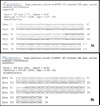Use of Multiple Displacement Amplification as Pre-polymerase Chain Reaction (Pre-PCR) to amplify genomic DNA of siphonapterids preserved for long periods in scientific collections
- PMID: 20840790
- PMCID: PMC2945329
- DOI: 10.1186/1756-3305-3-86
Use of Multiple Displacement Amplification as Pre-polymerase Chain Reaction (Pre-PCR) to amplify genomic DNA of siphonapterids preserved for long periods in scientific collections
Abstract
The recently developed Multiple Displacement Amplification technique (MDA) allows for the production of a large quantity of high quality genomic DNA from low amounts of the original DNA. The goal of this study was to evaluate the performance of the MDA technique to amplify genomic DNA of siphonapterids that have been stored for long periods in 70% ethanol at room temperature. We subjected each DNA sample to two different methodologies: (1) amplification of mitochondrial 16S sequences without MDA; (2) amplification of 16S after MDA. All the samples obtained from these procedures were then sequenced. Only 4 samples (15.4%) subjected to method 1 showed amplification. In contrast, the application of MDA (method 2) improved the performance substantially, with 24 samples (92.3%) showing amplification, with significant difference. Interestingly, one of the samples successfully amplified with this method was originally collected in 1909. All of the sequenced samples displayed satisfactory results in quality evaluations (Phred ≥ 20) and good similarities, as identified with the BLASTn tool. Our results demonstrate that the use of MDA may be an effective tool in molecular studies involving specimens of fleas that have traditionally been considered inadequately preserved for such purposes.
Figures





References
-
- Hopkins GHE, Rothschild M. An Illustrated Catalogue of the Rothschild Collection of Fleas (Siphonaptera) in the British Museum (Natural History), Vol. I, Tungidae and Pulicidae. British Museum (Natural History), London; 1953. p. 361.
-
- Lewis RE. Résumé of the Siphonaptera (Insecta) of the world. J. Med.l Entomol. 1998;35:377–389. - PubMed
-
- Linardi PM, Guimarães LR. Sifonápteros do Brasil. Museu de Zoologia- USP/FAPESP, São Paulo, Brazil; 2000. p. 291.
-
- Audy JR, Radovsky FJ, Vercammen-Grandfean PH. Neosomy: radical intrastadial metamorphosis associated with arthropod symbioses. J. Med. Entomol. 1972;9:487–494. - PubMed
LinkOut - more resources
Full Text Sources
Other Literature Sources

